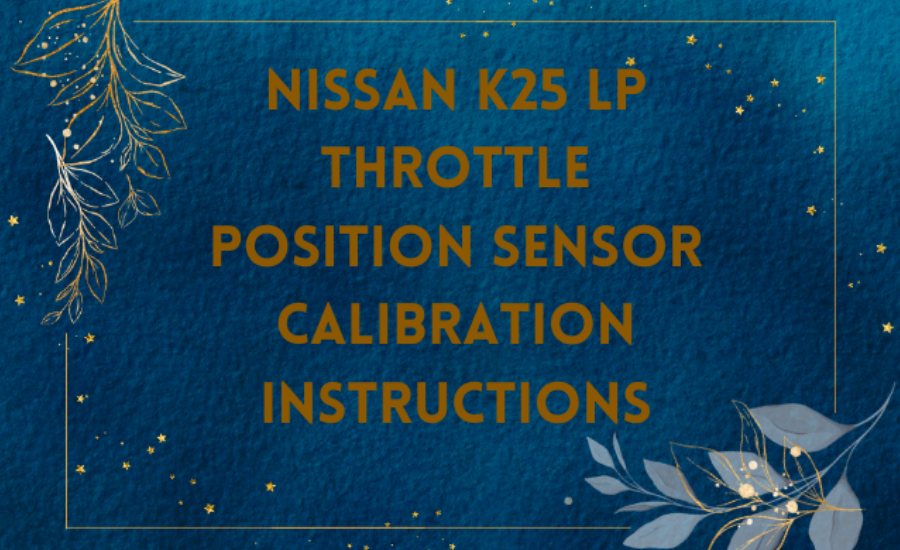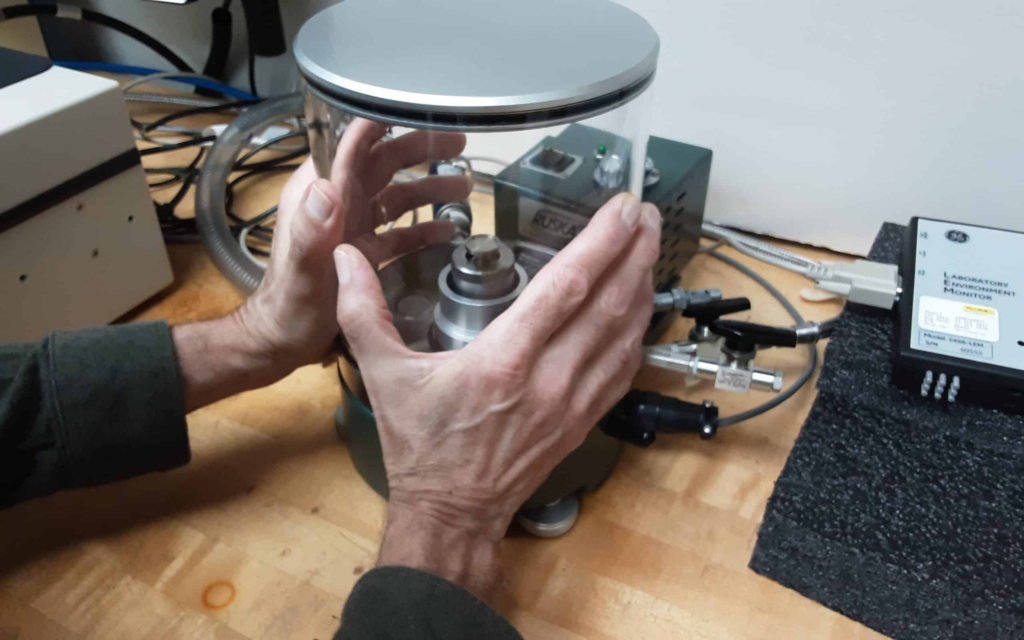Comprehensive Guide to Calibrating the Nissan k25 lp Throttle Position Sensor Calibration Instructions
Calibrating the Nissan k25 lp Throttle Position Sensor Calibration Instructions (TPS) is a crucial task to ensure your engine performs at its best. This step-by-step guide will walk you through the process, ensuring that the engine control unit (ECU) receives accurate data, leading to improved fuel efficiency and engine responsiveness. Calibration errors can result in poor acceleration, stalling, and increased fuel consumption, so it’s essential to follow these instructions carefully.
Understanding the Role of the Nissan k25 lp Throttle Position Sensor Calibration Instructions

The throttle position sensor in your Nissan K25 LP engine is vital for maintaining optimal performance. It measures the position of the throttle and relays this information to the ECU, which then adjusts the air-fuel mixture accordingly. Proper calibration of this sensor is critical to ensure your vehicle runs smoothly, delivering efficient and reliable performance.
The Significance of Accurate Calibration
Accurate calibration of the Nissan k25 lp Throttle Position Sensor Calibration Instructions is essential for optimal engine performance. Miscalibration can lead to the ECU receiving incorrect data, which in turn affects fuel efficiency and overall engine operation. Regular calibration is not just a maintenance task; it’s a necessity to prevent engine issues and avoid costly repairs down the line.
Recognizing Symptoms of a Miscalibrated Throttle Position Sensor
A miscalibrated Nissan K25 LP throttle position sensor can manifest in several ways, including:
- Decreased Fuel Efficiency: The engine may consume more fuel due to incorrect data from the sensor.
- Unexpected Stalling: Miscalibration can cause the engine to stall unexpectedly, especially at idle.
- Check Engine Light Activation: A faulty sensor often triggers the check engine light, signaling a problem.
- Rough or Inconsistent Idling: The engine may idle erratically, leading to a rough driving experience.
Identifying these symptoms early can save you from more significant issues, emphasizing the importance of regular calibration.
Essential Tools and Equipment for Calibration
Before you begin the calibration of your Nissan k25 lp Throttle Position Sensor Calibration Instructions it’s important to gather all the necessary tools and equipment to ensure the process is smooth and efficient.
Tools You’ll Need:
- Multimeter: For measuring voltage, current, and resistance.
- Screwdriver Set: Various sizes to handle different screws involved in the calibration.
- Wrench Set: Necessary for tightening and loosening nuts and bolts.
- Throttle Position Sensor (TPS): A replacement sensor in case the existing one is faulty.
- Service Manual: Specific to the Nissan K25 LP for reference during the calibration process.
Optional Equipment:
- Diagnostic Scanner: Useful for reading and clearing error codes.
- Gloves and Safety Glasses: For personal protection during the calibration process.
- Flashlight: Helpful for illuminating hard-to-see areas within the engine compartment.
Having these tools ready will streamline the calibration process, helping you achieve accurate results quickly.
Preparing Your Nissan K25 LP for Calibration
Proper preparation is key to a successful calibration of the Nissan K25 LP throttle position sensor. Follow these steps to ensure your vehicle is ready for the process.
Safety First:
- Turn Off the Engine: Ensure the engine is off before starting the calibration.
- Wear Protective Gear: Gloves and safety glasses are recommended to protect against potential hazards.
- Stabilize the Vehicle: Park on a flat surface and use wheel chocks to prevent movement.
- Disconnect the Battery: To avoid electrical shocks, disconnect the vehicle’s battery.
Initial Vehicle Checks:
- Throttle Body Inspection: Clean the throttle body if necessary to remove dirt or debris.
- Sensor Examination: Ensure the sensor is not damaged or loose.
- Battery Health Check: Ensure the battery is fully charged to avoid issues during calibration.
By following these preparatory steps, you’ll ensure a smoother calibration process, leading to better engine performance.
Locating the Throttle Nissan k25 lp Throttle Position Sensor Calibration Instructions

Before you can calibrate the throttle position sensor, you need to locate it within the engine compartment.
Engine Compartment Layout:
Start by opening the hood of your Nissan K25 LP forklift. With the engine off and cool, examine the engine layout to locate the throttle position sensor. You’ll find it near the throttle body, typically attached to it.
Identifying the Sensor:
The throttle position sensor is a small, cylindrical device connected to the throttle body by a wiring harness. Use the following identifiers to locate it:
- Throttle Position Sensor: Attached to the throttle body and connected via a wiring harness.
Step-by-Step Calibration Procedure for the Nissan K25 LP Throttle Position Sensor
Accurate calibration of the Nissan K25 LP throttle position sensor (TPS) is essential for optimal engine performance. Follow these detailed steps to ensure precise calibration.
Adjustment Process
- Reconnect the Sensor:
- After disconnecting the throttle position sensor, reattach it to its original mounting position on the throttle body.
- Perform the Adjustment:
- Measure Voltage: Using a diagnostic tool or multimeter, measure the sensor’s output voltage.
- Adjust the Sensor: Adjust the sensor until the voltage falls within the specifications outlined in the Nissan K25 LP service manual.
- Finalize Calibration:
- Turn off the ignition.
- Start the engine to test the throttle position sensor’s performance.
Reconnecting the Sensor and Testing Performance
- Reinstallation Procedure:
- Reconnect the Sensor: Securely attach the sensor back to its original position.
- Reconnect Wiring Harness: Plug the wiring harness back into the sensor and ensure all connections are secure.
- Secure Components: Check that all components are tightly fastened.
- Check for Obstructions: Ensure there are no obstructions around the sensor.
- Performance Testing:
- Monitor Idle Speed: Ensure that the idle speed is steady and consistent.
- Acceleration Check: Gradually accelerate the engine and listen for any unusual noises.
- Error Code Check: Use an OBD-II scanner to verify that no error codes are present.
If the engine passes these tests, the calibration process is successful, and the engine should perform at its best.
Troubleshooting Common Calibration Issues

Even with careful calibration, you might encounter some issues. Here’s how to address common problems:
- Frequent Calibration Issues:
- Erratic Idling: This could indicate misalignment of the sensor.
- Poor Acceleration: Difficulty in smooth acceleration might be due to faulty sensor wiring.
- Check Engine Light: If this light appears, it often signals a sensor issue.
- Advanced Troubleshooting Solutions:
- Use a Multimeter: Verify the sensor’s voltage is within the correct range.
- Inspect Wiring: Check for damaged or loose wiring connections.
- Software Updates: Updating the ECU software might resolve sensor-related issues.
By addressing these problems promptly, you can ensure the throttle position sensor is correctly calibrated and your engine operates smoothly.
Related: bison-32-085-0003-000
Frequently Asked Questions (FAQs) Nissan k25 lp Throttle Position Sensor Calibration Instructions
Q: What is the purpose of calibrating the throttle position sensor?
A: Calibration ensures that the engine control unit (ECU) receives accurate data about the throttle’s position, allowing the ECU to adjust the air-fuel mixture correctly. This improves engine performance, fuel efficiency, and acceleration.
Q: How often should I calibrate the throttle position sensor?
A: Calibration is typically recommended during regular maintenance or if you notice symptoms such as poor acceleration, rough idling, or a check engine light. Refer to your vehicle’s service manual for specific intervals or conditions for recalibration.
Q: What tools are required for calibration?
A: Essential tools include a multimeter, screwdriver set, wrench set, and possibly a replacement throttle position sensor. Optional tools are a diagnostic scanner and a torque wrench.
Q: Can I calibrate the throttle position sensor myself?
A: Yes, you can perform the calibration yourself if you have the necessary tools and follow the instructions carefully. If you’re unsure or uncomfortable, it’s advisable to seek help from a professional mechanic.
Q: What are common symptoms of a miscalibrated throttle position sensor?
A: Symptoms include decreased fuel efficiency, unexpected stalling, a check engine light, and rough or inconsistent idling. Addressing these symptoms early can prevent more severe engine problems.
Q: How can I verify if the calibration was successful?
A: After calibration, start the engine and observe its idle speed and acceleration. The engine should idle smoothly and accelerate without issues. Use an OBD-II scanner to confirm that no error codes are present.
Q: What should I do if calibration doesn’t resolve performance issues?
A: If problems persist, recheck the sensor’s voltage with a multimeter and inspect the wiring for damage. Sometimes, updating the ECU software may be necessary. If issues continue, consult a professional mechanic for further assistance.
Conclusion
Nissan k25 lp Throttle Position Sensor Calibration Instructions is crucial for maintaining engine performance and efficiency by ensuring the sensor provides accurate data to the ECU for proper air-fuel mixture adjustments. Proper calibration prevents issues like poor acceleration, stalling, and increased fuel consumption. To calibrate the sensor, gather the necessary tools, prepare your vehicle by ensuring safety and checking component conditions, and follow a detailed calibration procedure. After calibration, test the sensor to confirm correct operation, addressing any issues by checking voltage, inspecting wiring, and considering ECU software updates. Adhering to these steps helps your Nissan K25 LP engine run smoothly, improving driving experience and avoiding costly repairs.
Stay in the loop for upcoming updates and alerts. Brain Rusher






